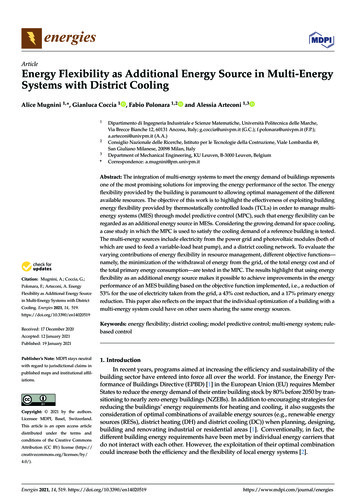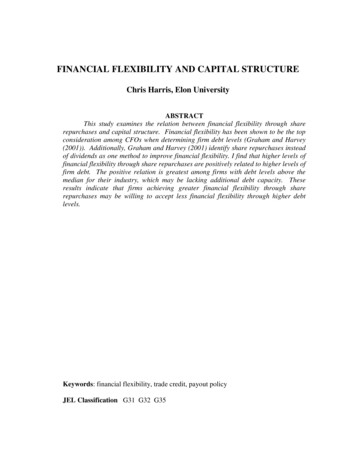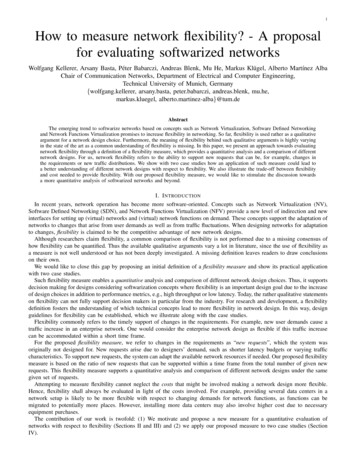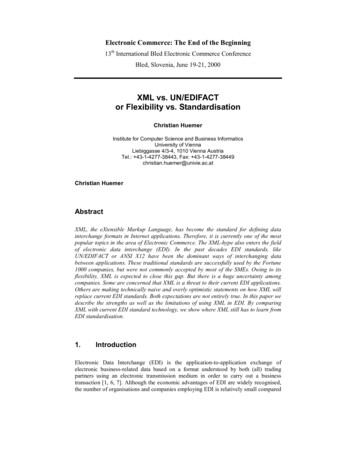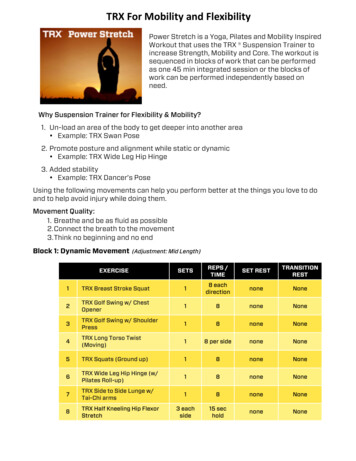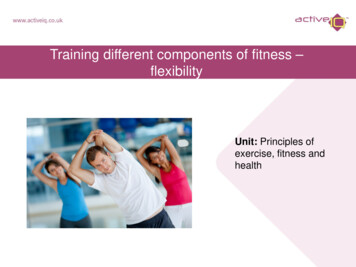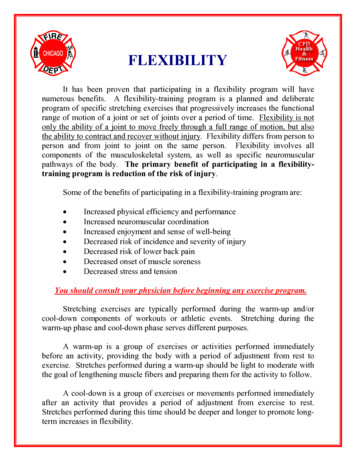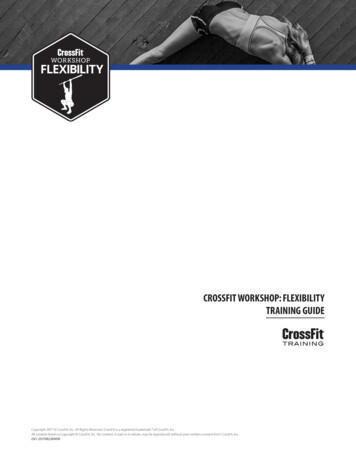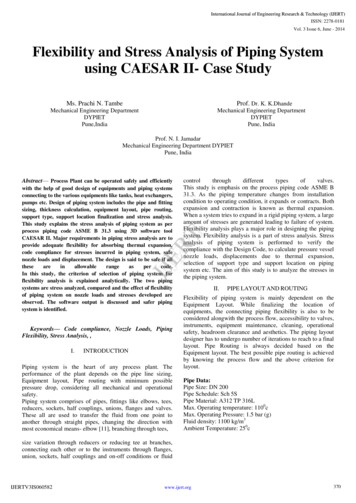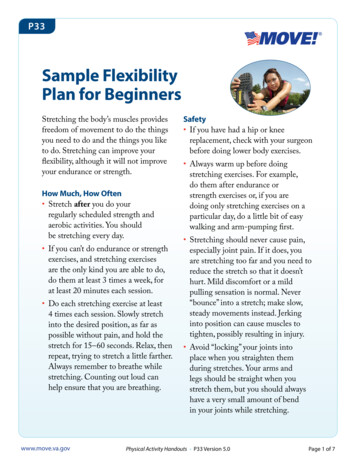
Transcription
P33Sample FlexibilityPlan for BeginnersStretching the body’s muscles providesfreedom of movement to do the thingsyou need to do and the things you liketo do. Stretching can improve yourflexibility, although it will not improveyour endurance or strength.How Much, How Often Stretch after you do yourregularly scheduled strength andaerobic activities. You shouldbe stretching every day. If you can’t do endurance or strengthexercises, and stretching exercisesare the only kind you are able to do,do them at least 3 times a week, forat least 20 minutes each session. Do each stretching exercise at least4 times each session. Slowly stretchinto the desired position, as far aspossible without pain, and hold thestretch for 15–60 seconds. Relax, thenrepeat, trying to stretch a little farther.Always remember to breathe whilestretching. Counting out loud canhelp ensure that you are breathing.www.move.va.govSafety If you have had a hip or kneereplacement, check with your surgeonbefore doing lower body exercises. Always warm up before doingstretching exercises. For example,do them after endurance orstrength exercises or, if you aredoing only stretching exercises on aparticular day, do a little bit of easywalking and arm-pumping first. Stretching should never cause pain,especially joint pain. If it does, youare stretching too far and you need toreduce the stretch so that it doesn’thurt. Mild discomfort or a mildpulling sensation is normal. Never“bounce” into a stretch; make slow,steady movements instead. Jerkinginto position can cause muscles totighten, possibly resulting in injury. Avoid “locking” your joints intoplace when you straighten themduring stretches. Your arms andlegs should be straight when youstretch them, but you should alwayshave a very small amount of bendin your joints while stretching.Physical Activity Handouts P33 Version 5.0Page 1 of 7
Some of the exercises require you tolie on the floor. If you are afraid to lieon the floor because you think youwon’t be able to get back up, considerexercising with a buddy, in a chair, orin the pool. Alternatively, keep a chairnearby to use as support in gettingup. All stretches can be modified.Getting StartedStretching exercises are generallyperformed at a low intensity. You canprogress in your stretching exercises;the way to know how to limit yourselfis that stretching should never hurt. Itmay feel slightly uncomfortable, but notpainful. Push yourself to stretch farther,but not so far that it hurts. Performthe following exercises, in order, asdescribed below.Detailed instructions for each exerciseare provided at the end of this handoutand are taken from Exercise: A Guidefrom the National Institute on Aging.STRETCH REPETITIONS, SETS, AND SESSIONSFlexibility Exercise/Stretch# of repetitionsper set# of setsper session# of sessionsper weekHamstrings4 per side1After every aerobic or strength sessionAlternative Hamstrings4 per side1After every aerobic or strength sessionCalves4 per side1After every aerobic or strength sessionAnkles4 per side1After every aerobic or strength sessionTriceps4 per side1After every aerobic or strength sessionWrists4 per side1After every aerobic or strength sessionQuadriceps4 per side1After every aerobic or strength sessionDouble Hip Rotation4 per side1After every aerobic or strength sessionSingle Hip Rotation4 per side1After every aerobic or strength sessionShoulder Rotation4 per side1After every aerobic or strength sessionNeck Rotation4 per side1After every aerobic or strength sessionSide Leg Raise4 per side1After every aerobic or strength sessionIf you are not currently doing aerobic or strength activities, do flexibility and stretching at least 3 times per weekfor at least 20 minutes per session.www.move.va.govPhysical Activity Handouts P33 Version 5.0Page 2 of 7
EXERCISESHamstringsStretches muscles in the back of the thigh Sit sideways on bench or other hard surface (such as two chairsplaced side by side). Keep one leg stretched out on bench, straight, toes pointing up. Keep other leg off of bench, with foot flat on floor. Straighten back. If you feel a stretch at this point, hold the position for 15–60seconds. If you don’t feel a stretch, lean forward from hips (not waist) untilyou feel stretching in leg on bench, keeping back and shouldersstraight. Omit this step if you have had a hip replacement, unlesssurgeon/therapist approves. Hold position for 15–60 seconds. Repeat with other leg. Repeat at least 4 times on each side.Alternative Hamstrings StretchStretches muscles in the back of the thigh Stand behind chair, holding on with both hands. Bend forward from the hips (not waist), keeping back andshoulders straight at all times. When upper body is parallel to floor, hold position for 15–60seconds. You should feel a stretch in the backs of your thighs. Repeat at least 4 times.CalvesStretches lower leg muscles in two ways: with knee straightand knee bent Stand with hands against wall, arms outstretched and elbowsstraight. Keeping your left knee slightly bent, toes of right foot slightlyturned inward, step back 1–2 feet with right leg, heel, and footflat on floor. You should feel a stretch in your calf muscle, butyou shouldn’t feel uncomfortable. If you don’t feel a stretch,move your foot farther back until you do.www.move.va.govPhysical Activity Handouts P33 Version 5.0Page 3 of 7
Hold position for 15–60 seconds. Bend knee of right leg, keep heel and foot flat on floor. Hold position for another 15–60 seconds. Repeat with left leg. Repeat at least 4 times for each leg.AnklesStretches front ankle muscles Remove your shoes. Sit toward the front edge of a chair and leanback, using pillows to support your back. Stretch legs out in front of you. With your heels still on the floor, bend ankles to point feettoward you. Next, bend ankles to point feet away from you. If you don’t feel the stretch, repeat with your feet slightly offthe floor. Hold the position for 15–60 seconds. Repeat at least 4 times.TricepsStretches muscles in back of upper arm Hold one end of a towel in right hand. Raise and bend right arm to drape towel down back. Keep yourright arm in this position, and continue holding onto the towel. Reach behind your lower back and grasp bottom end of towelwith left hand. Climb left hand progressively higher up towel, which also pullsyour right arm down. Continue until your hands touch, or asclose to that as you can comfortably go. Hold for 15–60 seconds. Reverse positions. Repeat each position at least 4 times.www.move.va.govPhysical Activity Handouts P33 Version 5.0Page 4 of 7
WristsStretches wrist muscles Place hands together, in praying position. Slowly raise elbows so arms are parallel to floor,keeping hands flat against each other. Hold position for 15–60 seconds. Repeat at least 4 times.FLOOR EXERCISESAbout Floor ExercisesMost of the remaining exercises aredone on the floor and stretch somevery important muscle groups. If youare afraid to lie on the floor to exercisebecause you think you won’t be able toget back up, consider using the buddysystem to do these. Find a buddy whowill be able to help you.Knowing the right way to get into alying position on the floor and to getback up also may be helpful. If youhave had a hip replacement, check withyour surgeon before using the followingmethods. If you have osteoporosis,check with your doctor first.To get into a lying position:To get up from a lying position: Stand next to a very sturdy chair that won’t tipover (put chair against wall for support if youneed to). Roll onto your left side. Put your hands on the seat of the chair. Use your right hand, placed on the floor atabout the level of your ribs, to push yourshoulders off the floor. Lower yourself down on one knee. Your weight is on your left hip. Bring the other knee down. Roll forward, onto your knees, leaning on yourhands for support. Lean your hands on theseat of the chair you used to lie down. Put your left hand on the floor and lean on itas you bring your left hip to the floor. Your weight is now on your left hip. Straighten your legs out. Leaning your hands on the seat of the chair forsupport, rise from this position. Lie on your left side. Roll onto your back.Note: You don’t have to use your left side.You can use your right side, if you prefer.www.move.va.gov Lift one of your knees so that one leg is bent,foot flat on the floor.Note: You don’t have to use your left side.You can reverse positions, if you prefer.Physical Activity Handouts P33 Version 5.0Page 5 of 7
QuadricepsStretches muscles in front of thighs Lie on side on the floor. Your hips should be lined up sothat one is directly above the other one. Rest head on pillow or hand. Bend knee that is on top. Reach back and grab heel of that leg. If you can’t reachyour heel with your hand, loop a belt over your foot andhold belt ends. Gently pull that leg until front of thigh stretches. Hold position for 15–60 seconds. Reverse position and repeat. Repeat at least 4 times on each side. If the back of yourthigh cramps during this exercise, stretch your leg andtry again, more slowly.Shoulder RotationStretches shoulder muscles Lie flat on floor, pillow under head, legs straight. If your backbothers you, place a rolled towel under your knees. Stretch arms straight out to side. Your shoulders and upper armswill remain flat on the floor throughout this exercise. Bend elbows so that your hands are pointing toward the ceiling. Let your arms slowly roll backwards from the elbow. Stop whenyou feel a stretch or slight discomfort, and stop immediately ifyou feel a pinching sensation or a sharp pain. Hold position for 15–60 seconds. Slowly raise your arms, still bent at the elbow, to point towardthe ceiling again. Then let your arms slowly roll forward,remaining bent at the elbow, to point toward your hips. Stopwhen you feel a stretch or slight discomfort. Hold position for 15–60 seconds. Alternate pointing above head, then toward ceiling, then towardhips. Begin and end with pointing-above-head position. Repeat 4 times.www.move.va.govPhysical Activity Handouts P33 Version 5.0Page 6 of 7
Double Hip RotationStretches outer muscles of hips and thighs. Unless yoursurgeon approves, don’t do this exercise if you have had ahip replacement Lie on floor on your back, knees bent and feet flat on the floor. Keep shoulders on floor at all times. Keeping knees bent and together, gently lower legs to oneside as far as possible without forcing them. Hold position for 15–60 seconds. Return legs to upright position. Repeat toward other side. Repeat at least 4 times on each side.Single Hip RotationStretches muscles of pelvis and inner thigh. Unless yoursurgeon approves, don’t do this exercise if you have had ahip replacement Lie on your back on floor, knees bent and feet flat on the floor. Keep shoulders on floor throughout exercise. Lower one knee slowly to side, keeping the other leg and yourpelvis in place. Hold position for 15–60 seconds. Bring knee back up slowly. Repeat with other knee. Repeat at least 4 times on each side.Neck RotationStretches neck muscles Lie on the floor with a phone book or other thick bookunder your head. Slowly turn head from side-to-side, holding position eachtime for 15–60 seconds on each side. Your head shouldnot be tipped forward or backward, but should be in acomfortable position. You can keep your knees bent tokeep your back comfortable during this exercise. Repeat at least 4 times.www.move.va.govPhysical Activity Handouts P33 Version 5.0Page 7 of 7
www.move.va.gov Physical Activity Handouts P33 Version 5.0 Page 1 of 7 P33 Sample Flexibility Plan for Beginners Stretching the body’s muscles provides freedom of movement to do the things you need to do and the things you like
